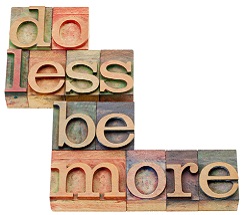Do you ever wonder where that term “less is more” comes from?
Many people think that Ludwig Mies van der Rohe, one of the founders of the modern architectural movement, was the first to use it. Actually, it was the English poet Robert Browning who wrote the famous line in 1855. Regardless of the word’s origins, what can be applied to architecture or poetry can and should be applied to our work as educators.
In this time of 20th-Century education focus, a time when we’re working hard to stay current in our practice, it’s easy to feel overwhelmed. Everywhere you turn, a new strategy is being suggested or a new tech tool is popping up. You may be asking yourself, Where does it end? How do I keep it all together? How do I keep a balance? Where do I find the energy to keep going? How do I know that I’m providing the best support to my students? I’ve witnessed this stress take over the lives of many teachers at schools where I’ve been the principal. It’s not pretty.
So…how do we hold it all together? How do we ensure that we are bringing our best to the classroom without losing it? We do it by remembering that “less is more”.
I’m a strong believer in that phrase and offer three suggestions to support you:
1) Preparation and planning wisely
Easier said than done, right? Not really. If you make good use of your time, it can be achieved. Are you an elementary teacher who is responsible for teaching many curricular concepts? OK. Take the time to review the lesson content for the week, month and even year. See where there are overlaps in, say, Math, Science and Social Studies. Instead of teaching all that content separately, incorporate it in one or 2 lessons. Add a great story from Social Studies content and use it to replace a Language Arts lesson. Take that Math concept and show how it’s used in the science realm. No need to pick apart every content area and teach it in isolation. Use your creativity and combine lesson content. It will flow so much better in your work day. Instead of thinking of instructional minutes, think of your time as learning minutes. Where can you get the best learning achieved for your students in the time that that you have with them? Prepare your lessons around themes of “less is more” and stick to it!
2) Collaborate with Colleagues
Why do so many educators teach or plan in isolation? It’s so unnecessary and so counter-productive to being perceived as 20th-Century educators. If you are not doing suggestion #1 (above) in collaboration with other educators, you are selling yourself short. The power that a colleague or planning team can bring to your work is crucial. It can make the difference between spending long days vs. short hours of planning. It can bring vibrancy to the area that’s not your strength and support the same in a colleague. As a principal, I’ve witnessed grade-level teams planning out the whole year in less than 3 days, including all lesson plans prepared via a Word or Google doc, because they did it in collaboration! I’ve also sadly witnessed the tremendous stress in teachers who didn’t have a collaborative team to plan with. Don’t let that happen to you or anyone else at your site. Open your door, your heart, your mind. Choose to collaborate and learn more by doing less.
3) Pick one tech tool and use it well
There are amazing tools on the web. We call them “Web 2.0 tools”. As a 20th-Century educator, you are eager to embrace as many of these tools as possible. Going to workshops, learning how to use them, sharing them with your students, and forgetting why you thought they were good idea in the first place. STOP! In the rush to use a wiki, blog or social media site with your students, it’s easy to lose the focus for the lesson. What’s MORE important is to see the power of what one tool can do to make a difference in your work and learn how to use that tool well. Maybe it’s starting a blog and using that with students to teach writing. Or building a wiki to house all your algebra content that students and parents can have access to. Whatever the tool, choosing to use one and using it well will be far more meaningful to your work than grappling with 6 that your colleague said you MUST use. Remember, you want to use technology to: Teach less, learn more.
As a former principal, I share these three suggestions (which may not be new to you) because it’s easy in our daily work as educators to get caught up with all the content and lose the meaning. It’s also easy to get too invested in too many things which can bring us to a point of having our health or classroom relationships suffer. Remember, it’s the quality – not the quantity – of your lessons that makes the difference. Let your classroom time with students be an inspiration because you choose to do more with less!!
